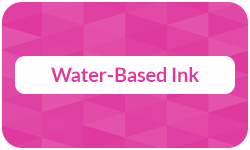
The variety of printing inks is vast, whether it is solid ink, pigment ink, or even types with special effects. Each of them has its unique capabilities and limitations, challenging printing services and private printers with tough decisions. One widely used type of printing ink is water-based ink, which uses, as the name suggests, water as the base to carry the color. The following article will tell you all about the intricacies of water-based ink and what it can be used for.
Definition: Water-based ink
Contrary to other types of inks, water-based inks use water as the main base for carrying the pigments of the ink. Depending on the pigment used, it is more environmentally friendly while still producing a vibrant image.
High-quality color copies from just $0.18
- Choose from different paper formats & paper weights
- Configure finishing options & add any extras you need
- Easy online ordering process with delivery to your doorstep
Learn more!
Applications and limitations
Water-based inks are often used for paper or cardboard, as well as wallpapers and prints on food packaging, as they are environmentally friendly. However, it can also be used on some non-porous surfaces, such as plastic film packaging. Furthermore, as the ink is water-soluble, when it is used to print on clothing, the print will soften with each washing instead of keeping it stiff.
On the other hand, how environmentally friendly the ink is depends on the pigment used. Due to the water-solvent character, if it is made from polymers or acrylic resins, those chemicals can be washed away easily and enter the ecosystem. Moreover, as previously mentioned, water-based ink is not water-resistant and easily smudges when the surface gets wet. And lastly, the setting process can take quite long, as the water needs to fully evaporate.
Advantages and disadvantages
Water-based ink has many advantages and disadvantages to consider before deciding on using it.
Advantages
- Cheap, as water is the main ingredient
- Sustainable, as there are fewer toxic substances in it
- Soft texture after washing the fabric
- Versatility in mediums to print on
Disadvantages
- Slow setting process as the water needs time to evaporate
- Not water-resistant
- Not sustainable if chemical pigments are used in the ink
A5 printing at BachelorPrint from $0.09
- Smaller prints in A5 size for flyers or cards
- Quick and easy configuration in our online shop
- Select your preferred paper weight, finishing options & add-ons
Learn more!
FAQs
Water-based ink uses water as the main base to carry the pigment in a suspension. It is favored, especially because of the cheaper price and versatility in printing.
Yes and no. As water is the main ingredient, it does include fewer toxic substances. However, it is important to note that the sustainability of this ink depends on the pigment or possible other ingredients as the water also allows toxic substances to be washed out easily.
Water-based ink has many advantages, for example its versatility in applications or sustainability depending on what types of pigments are used. Furthermore, as water is the main ingredient, it is also considered cheaper than other types of inks and if printed on fabric, the surface softens after washing because the pigments are washed into the fabric.
Yes. Water-based ink is relatively permanent, as the dye seeps deep into fabric, fixing the color in the fibers instead of layering it on top. This is why it is very durable.